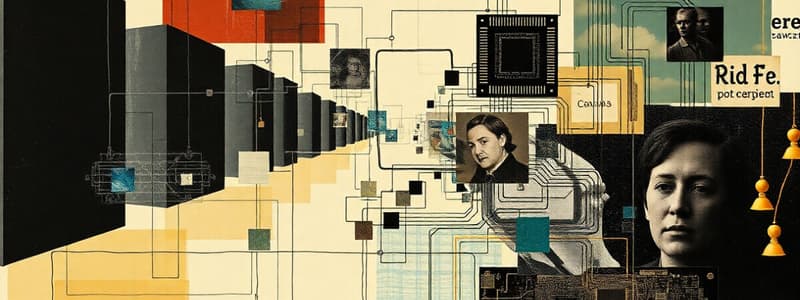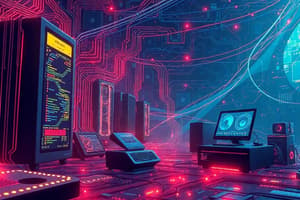Podcast
Questions and Answers
What is the primary role of feedback in a control system?
What is the primary role of feedback in a control system?
- To eliminate the need for input in controlling outputs
- To maintain fixed outputs regardless of environment changes
- To provide information that informs the next output decision (correct)
- To ensure that outputs are consistent over time
How does feedback contribute to the stability of a control system in traffic management?
How does feedback contribute to the stability of a control system in traffic management?
- By creating unpredictable traffic patterns
- By preventing any traffic movement until conditions normalize
- By allowing real-time adjustments based on current traffic conditions (correct)
- By providing a fixed schedule for traffic light changes
What distinguishes dynamic control traffic lights from fixed-time traffic lights?
What distinguishes dynamic control traffic lights from fixed-time traffic lights?
- Dynamic control lights adjust based on environmental feedback (correct)
- Dynamic control lights require manual operation
- Dynamic control lights rely on fixed programming
- Dynamic control lights do not change color
What happens after the output of a control system affects the input?
What happens after the output of a control system affects the input?
What is likely to occur if a traffic system lacks effective feedback mechanisms?
What is likely to occur if a traffic system lacks effective feedback mechanisms?
What is the primary function of a sound sensor?
What is the primary function of a sound sensor?
Which type of sensor is primarily used in digital cameras?
Which type of sensor is primarily used in digital cameras?
Which sensor is commonly used to conserve energy in lighting systems?
Which sensor is commonly used to conserve energy in lighting systems?
What do pressure sensors primarily measure?
What do pressure sensors primarily measure?
Which of the following sensors can detect nearby objects without contact?
Which of the following sensors can detect nearby objects without contact?
In the context of sensors, what is a transducer?
In the context of sensors, what is a transducer?
What application utilizes infrared (IR) sensors?
What application utilizes infrared (IR) sensors?
Which sensor is often used in touch-screen devices?
Which sensor is often used in touch-screen devices?
What is a significant limitation of control systems that rely on microprocessors?
What is a significant limitation of control systems that rely on microprocessors?
How does an Analog-to-Digital Converter (ADC) function in a control system?
How does an Analog-to-Digital Converter (ADC) function in a control system?
Which characteristic of a sensor defines the smallest detectable increment of measurement?
Which characteristic of a sensor defines the smallest detectable increment of measurement?
What should an ideal sensor be insensitive to in order to provide reliable measurements?
What should an ideal sensor be insensitive to in order to provide reliable measurements?
Which of the following properties is NOT a quality determining factor for sensors?
Which of the following properties is NOT a quality determining factor for sensors?
What is a practical implication of microprocessors being pre-programmed systems?
What is a practical implication of microprocessors being pre-programmed systems?
What is the consequence of sensors not influencing the measured property?
What is the consequence of sensors not influencing the measured property?
Why is it crucial for a temperature sensor to have an appropriate range?
Why is it crucial for a temperature sensor to have an appropriate range?
What is the primary function of a transducer in computer systems?
What is the primary function of a transducer in computer systems?
How do sensors classify as transducers?
How do sensors classify as transducers?
What role do actuators play in a control system?
What role do actuators play in a control system?
What device converts the electrical signal into an electronic signal for processing?
What device converts the electrical signal into an electronic signal for processing?
What are the main components of a computer system as described?
What are the main components of a computer system as described?
Which of the following correctly characterizes microcontrollers?
Which of the following correctly characterizes microcontrollers?
What happens after the processor outputs an electronic signal in the control system?
What happens after the processor outputs an electronic signal in the control system?
Which statement accurately describes the conversion process in transducers?
Which statement accurately describes the conversion process in transducers?
What role does a GPU play in a computer system?
What role does a GPU play in a computer system?
What type of energy do actuators convert electrical signals into?
What type of energy do actuators convert electrical signals into?
What distinguishes a general-purpose microprocessor from an embedded controller?
What distinguishes a general-purpose microprocessor from an embedded controller?
Which of the following statements about control systems is true?
Which of the following statements about control systems is true?
Which of the following devices is classified as a transducer?
Which of the following devices is classified as a transducer?
What advantage do microprocessors provide to control systems?
What advantage do microprocessors provide to control systems?
In what way are embedded controllers beneficial for electronic devices?
In what way are embedded controllers beneficial for electronic devices?
Which statement about microprocessors is incorrect?
Which statement about microprocessors is incorrect?
Flashcards
Sound Sensor
Sound Sensor
A device that detects sound waves and is commonly used in microphones.
Motion Sensor
Motion Sensor
A sensor that detects moving objects, often used in security systems.
Vibration Sensor
Vibration Sensor
Detects vibrations on surfaces, used in security and musical instruments.
Active Pixel Sensor (APS)
Active Pixel Sensor (APS)
Signup and view all the flashcards
Infrared Sensor
Infrared Sensor
Signup and view all the flashcards
Pressure Sensor
Pressure Sensor
Signup and view all the flashcards
Temperature Sensor
Temperature Sensor
Signup and view all the flashcards
Proximity Sensor
Proximity Sensor
Signup and view all the flashcards
Error-free control systems
Error-free control systems
Signup and view all the flashcards
Embedded microprocessors
Embedded microprocessors
Signup and view all the flashcards
Analog-to-Digital Converter (ADC)
Analog-to-Digital Converter (ADC)
Signup and view all the flashcards
Sensor accuracy
Sensor accuracy
Signup and view all the flashcards
Sensor range
Sensor range
Signup and view all the flashcards
Sensor resolution
Sensor resolution
Signup and view all the flashcards
Sensor insensitivity
Sensor insensitivity
Signup and view all the flashcards
Passive sensor behavior
Passive sensor behavior
Signup and view all the flashcards
Input, Process, Output
Input, Process, Output
Signup and view all the flashcards
Control System
Control System
Signup and view all the flashcards
Microprocessor
Microprocessor
Signup and view all the flashcards
General Purpose Microprocessor
General Purpose Microprocessor
Signup and view all the flashcards
Embedded Controller
Embedded Controller
Signup and view all the flashcards
Graphics Processing Unit (GPU)
Graphics Processing Unit (GPU)
Signup and view all the flashcards
Fast Data Processing
Fast Data Processing
Signup and view all the flashcards
Integration of Sensors
Integration of Sensors
Signup and view all the flashcards
Feedback
Feedback
Signup and view all the flashcards
Dynamic control traffic lights
Dynamic control traffic lights
Signup and view all the flashcards
Fixed time traffic lights
Fixed time traffic lights
Signup and view all the flashcards
Output
Output
Signup and view all the flashcards
Transducers
Transducers
Signup and view all the flashcards
Transduction
Transduction
Signup and view all the flashcards
Sensors
Sensors
Signup and view all the flashcards
Actuators
Actuators
Signup and view all the flashcards
Digital-to-Analog Converter (DAC)
Digital-to-Analog Converter (DAC)
Signup and view all the flashcards
Electrical Signal
Electrical Signal
Signup and view all the flashcards
Study Notes
Computer Systems
- Computer systems primarily involve input, processing, and output.
- Input is provided to the system, processed using algorithms, and then an action is performed.
- The results of the action can be measured by a control system, providing feedback as input.
- Examples of systems using this model include heating systems, taxi meters, elevators, washing machines, process control, and device drivers.
Microprocessor
- A microprocessor is a small processor containing most or all of a central processing unit (CPU) function on a single integrated circuit (IC).
- It performs arithmetic and logic operations, and other data operations using registers.
- Microprocessors can be categorized as general purpose, embedded controllers, or microcontrollers, or graphing processing units (GPUs).
General Purpose Microprocessor
- These are capable of running many different programs and are often integrated into larger systems.
- A desktop computer's CPU is a general purpose microprocessor.
- These systems often include peripheral devices and external memory.
Embedded Microcontroller
- Microcontrollers are stand-alone chips that perform specific tasks.
- They require less power and are smaller than general-purpose microprocessors.
- They can be integrated into smaller electronic devices.
Graphics Processing Unit (GPU)
- GPUs are specialized microprocessors used for computer graphics.
- They are responsible for processing graphics-related mathematical calculations to create realistic images.
- They handle tasks such as calculating and rendering polygons and pixels on the screen.
Microprocessor Improvements to Control Systems
- Microprocessors aid control systems by improving efficiency and effectiveness in reading sensor input.
- Algorithms process the sensor input leading to specific actions.
Analog-to-Digital Converters (ADCs)
- ADCs convert continuous physical quantities (e.g., speed, temperature, humidity) into discrete digital signals.
- They are crucial for microprocessors to process sensor inputs.
- Sensors output data and are a fundamental part of control systems.
Sensor Characteristics
- Accuracy: Determines if measurements are correct (e.g., 18°C should not be measured as 19°C).
- Range: Defines the acceptable range for measurement (e.g., -30°C to 60°C temperature range).
- Resolution: Determines the smallest detectable increment in measurement (e.g., 1°C or 0.1°C).
- Insensitivity: Sensors shouldn't be affected by other physical conditions.
- Non-influencing: Sensors shouldn't affect the property being measured.
Sensor Types
- Sound: Detect sound waves (e.g., microphones).
- Motion: Detect moving objects (security, lighting).
- Vibration: Detect vibrations (security, musical instruments).
- Optical/Image: Include active pixel sensors and infrared sensors.
- Pressure: Measure pressure (touch screens, automotive).
- Temperature: Measure temperature (thermostats).
- Proximity: Detect nearby objects without contact.
Processors in Computer Systems
- Processors perform arithmetic and logical operations and form the core of computer systems.
- They receive inputs from sensors, process them, and produce outputs.
- Transducers convert physical quantities into electrical signals and vice-versa.
- Actuators are devices that convert electric or other signals into mechanical motion.
Feedback in Control Systems
- Feedback uses output information to adjust the input.
- This allows control systems to respond to changes in their environments to maintain a stable state.
Output in Control Systems
- Outputs are results of processing actions performed by control systems.
- Feedback is essential for ensuring stable outputs by responding to changes in the environment.
Studying That Suits You
Use AI to generate personalized quizzes and flashcards to suit your learning preferences.




